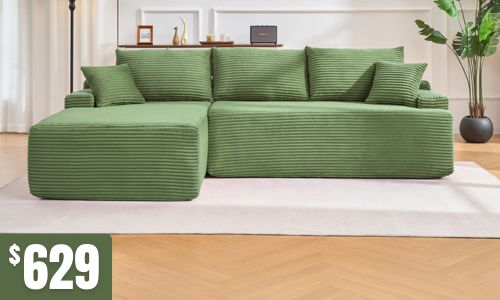Posts tagged with 'accessibility'

In the realm of furniture design, functionality and aesthetics often take centre stage. However, there is a fascinating and crucial aspect that goes beyond mere form and function – the science of human-centric furniture design. This innovative approach focuses on creating furniture that not only fits the human body but also enhances well-being, productivity, and overall quality of life. In this article, we delve into the realm of human-centric furniture design and explore its impact on our daily lives.
The Essence of Human-Centric Design
Human-centric furniture design revolves around the principle of putting the human experience at the forefront of the creative process. It goes beyond traditional ergonomics by considering the intricate relationship between furniture and human behaviour, emotions, and physical well-being. By understanding how people interact with their environment, designers can craft furniture that seamlessly integrates into our lives, promoting comfort and holistic satisfaction.’
- Biomechanics and Movement
Human bodies are designed for movement, and furniture should support this natural inclination. Human-centric design takes into account the body's biomechanics, ensuring that furniture promotes dynamic postures and encourages physical activity. From adjustable desks that allow seamless transitions between sitting and standing to chairs with flexible backrests that mimic the spine's movement, this approach helps prevent discomfort and enhances overall health.
- Emotional Well-being
Furniture has the power to evoke emotions and influence our psychological state. Human-centric design explores how different materials, colours, and shapes can impact our mood and mental well-being. Soft curves, natural textures, and calming hues can create a sense of tranquillity, while vibrant colours and innovative designs can inspire creativity and energy.
- Cognitive Performance
Our surroundings significantly affect cognitive functions such as concentration, problem-solving, and creativity. Human-centric furniture design takes into account the cognitive aspects of comfort, incorporating features like optimal lighting, noise reduction, and spatial organisation. Thoughtfully designed workspaces and study areas can enhance focus and boost productivity.
- Inclusivity and Accessibility
A truly human-centric approach embraces inclusivity, ensuring that furniture is accessible and adaptable for people of all ages and abilities. Height-adjustable tables, intuitive controls, and supportive seating accommodate diverse needs, creating an environment where everyone can thrive.
- Technology Integration
In today's digital age, technology is seamlessly integrated into our lives. Human-centric furniture design incorporates technology in ways that enhance user experience without compromising comfort or aesthetics. Wireless charging surfaces, smart furniture that adjusts to user preferences, and integrated charging ports are just a few examples of how technology can be harmoniously fused with design.
- Adaptability and Longevity
Furniture designed with humans in mind is versatile and enduring. Adaptable pieces such as modular sofas or foldable dining tables that evolve with changing needs promote a sense of attachment and longevity. The result is less waste and a more sustainable consumption pattern.
- Cultural and Social Context
Human-centric design also acknowledges the cultural and social contexts in which furniture is used. It respects traditions, values, and customs, creating pieces that resonate with users on a personal and cultural level.
The science of human-centric furniture design transcends the boundaries of conventional ergonomics. It intertwines the physical, emotional, cognitive, and social aspects of human experience to create furniture that harmonises with our lives in profound ways. As we continue to explore the depths of this approach, our furniture evolves from mere objects into holistic tools that nurture well-being and elevate the human spirit. So, the next time you sit in a thoughtfully designed chair or work at a seamlessly integrated desk, remember that you are experiencing the art and science of human-centric design in action.
Check our affordable human-centric furniture selections!
.jpg)
When it comes to choosing storage furniture for your home, tallboys and lowboys are two popular options to consider. These furniture pieces provide ample storage space while also adding style to your living spaces. But which style is the right fit for your storage needs? Let's explore the characteristics and benefits of tallboys and lowboys to help you make an informed decision.
Tallboys and lowboys are types of storage furniture typically used in bedrooms, living rooms, or any area where additional storage is needed. They are characterized by their vertical or horizontal orientation and multiple drawers or compartments, allowing for organized storage of various items.
The primary difference between a tallboy and a lowboy lies in their proportions and height. A tallboy is a tall, narrow piece of furniture with several drawers stacked vertically. It offers more vertical storage space while occupying less floor area, making it an excellent choice for rooms with limited space. On the other hand, a lowboy, also known as a wide chest or dresser, is a shorter and wider piece with drawers arranged horizontally. It provides a broader surface area on top, making it suitable for displaying decor or serving as a media console.
What are the advantages of tallboys?
Tallboys offer several advantages that make them a popular choice for storage needs:
- Vertical Storage: With their tall and slim design, tallboys maximize vertical space, making them ideal for rooms with the limited floor area. They provide ample storage capacity without taking up much room, allowing you to store a variety of items from clothing and accessories to books and linens.
- Space-Saving: Tallboys are an efficient storage solution as they take advantage of vertical space while requiring less horizontal space. This makes them particularly suitable for smaller bedrooms or apartments where optimizing floor space is crucial.
- Accessibility: The vertical arrangement of drawers in Tallboys allows for easy access and organisation of items. You can categorize and separate belongings in different drawers, making it convenient to find what you need without digging through cluttered storage space.
What are the advantages of lowboys?
Lowboys offer unique benefits that make them a versatile storage option:
- Surface Area: Lowboys have a wider top surface area, providing an opportunity for decorative displays or functional purposes. You can place a mirror, artwork, or other decor items on top, creating an attractive focal point in your room.
- Spacious Drawers: Lowboys often feature larger and wider drawers compared to tall boys. This makes them suitable for storing bulkier items such as sweaters, blankets, or larger clothing items.
- Versatility: Due to their horizontal design, lowboys can serve various purposes beyond bedroom storage. They can be used as TV stands, media consoles, or even entryway storage, offering both style and functionality to different areas of your home.
How do I choose between a tallboy and a lowboy?
When deciding between a tallboy and a lowboy, consider the following factors:
- Space: Assess the available space in your room. If you have limited floor space but ample vertical space, a tall boy would be a suitable choice. For wider rooms or areas where a broader surface is needed, a lowboy can be more fitting.
- Storage Needs: Evaluate the type and quantity of items you need to store.
- Style and Aesthetics: Consider the overall style and aesthetic of your room and how the tallboy or lowboy will complement your existing decor. Tallboys with their sleek and vertical design can create a more modern and minimalist look, while lowboys with their wider top surface can add a touch of elegance and versatility.
- Budget: Take into account your budget and the cost of the furniture pieces. Tallboys and lowboys vary in price depending on factors such as material and design. Determine your budget range and explore options that fit within your financial means.
Both tallboys and lowboys offer unique advantages and cater to different storage needs. Consider the available space, storage requirements, style preferences, and budget when making your decision. By carefully evaluating these factors, you can choose the style that best fits your storage needs and enhances the overall aesthetics of your home. Check our tallboy and lowboy selections!
 When it comes to creating a productive and organised home office, storage solutions play a vital role. Having a clutter-free workspace not only enhances your productivity but also helps create a sense of order and focus. Two essential storage options for any home office are file cabinets and display shelves. In this article, we'll explore the power of storage and why file cabinets and display shelves are crucial for maintaining an efficient and productive home office environment.
When it comes to creating a productive and organised home office, storage solutions play a vital role. Having a clutter-free workspace not only enhances your productivity but also helps create a sense of order and focus. Two essential storage options for any home office are file cabinets and display shelves. In this article, we'll explore the power of storage and why file cabinets and display shelves are crucial for maintaining an efficient and productive home office environment.
What are the benefits of having a file cabinet in a home office? File cabinets offer several benefits for a home office:
- Organisation:
File cabinets provide a dedicated space to store and organise important documents, papers, and files. With designated drawers and compartments, you can easily categorize and access your documents, eliminating the need for piles of paperwork on your desk.
- Security:
A file cabinet offers a secure storage solution for sensitive and confidential documents. You can lock the cabinet to prevent unauthorized access, ensuring the privacy and protection of your valuable information.
- Space Optimisation:
By storing your files vertically in a file cabinet, you can save valuable desk space. This allows you to have a clutter-free workspace, promoting better focus and productivity.
- Quick Retrieval:
With a file cabinet, you can establish a systematic filing system, making it easier to locate and retrieve specific documents whenever needed. This saves you time and minimises the frustration of searching through stacks of papers. Preservation: File cabinets provide a safe environment for preserving important documents. They protect your files from dust, moisture, and other potential damage, ensuring their longevity.
Why are display shelves important for a home office? Display shelves offer several benefits for a home office:
- Organisation and Accessibility:
Display shelves provide a designated space to showcase and organise frequently used items such as books, reference materials, and supplies. This keeps them easily accessible and within reach, reducing the time spent searching for essential items.
- Visual Appeal:
Display shelves can enhance the aesthetics of your home office. By arranging items in an organised and visually pleasing manner, they add a touch of style and personality to your workspace. This can contribute to a more inspiring and motivating environment.
- Inspirational Display:
Display shelves offer an opportunity to showcase items that inspire and motivate you. Whether it's displaying awards, artwork, or personal mementos, these visual reminders can help create a positive and uplifting atmosphere in your home office. Maximizing
- Vertical Space:
Display shelves utilize vertical space, allowing you to make the most of your office's available area. By taking advantage of the wall space, you can free up valuable desk or floor space and create a more open and spacious environment.
- Storage Expansion:
Display shelves can serve as additional storage options. You can use decorative baskets, bins, or boxes on the shelves to store and organise smaller items, reducing clutter on your desk and promoting a tidy workspace.
In conclusion, file cabinets and display shelves are essential storage solutions for a productive home office. File cabinets offer organisation, security, and quick retrieval of important documents, while display shelves provide organisation, accessibility, visual appeal, and storage expansion. By incorporating these storage options into your home office, you can create an efficient, organised, and inspiring workspace that enhances your productivity and focus.
Check our file cabinets and display shelves!




.jpeg)

 (3).jpeg)
